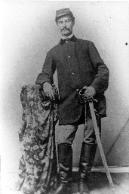| Fathers and Son: Hero and Plotter |
| Hubert Anton Casimir Dilger, 1836-1911, was noted as one of the finest artillerist in the Army of the Potomac. He was born in Germany's Black Forest and educated at Karlsruhe Military Academy, after which he served as a lieutenant in the Grand Duke's Horse Artillery where he developed new theories on artillery tactics and drill. When the American Civil War broke out, Dilger sailed to the United States and took up residence in Ohio where he became the captain of Battery I, 1st Ohio Light Artillery. Nicknamed "Leatherbreeches" for the doeskin German-style britches he wore, he turned his Ohio battery into a well-oiled fighting unit. He fought at several battles of the Army of the Potomac, including the Second Battle of Bull Run. |
| After the war, Dilger became wealthy and moved to a large horse farm in Virginia's Shenandoah Valley near Front Royal, where he began raising cattle as well as a family. Gored once by a bull, he survived and lived into the new century. |
| Dilger's son Anton was born at the Virginia farm in February of 1884, but at age nine moved to Germany with a married older sister for his education. He trained as a physician in Heidelberg and Munich, later working for the Heidelberg University surgical clinic. He received his doctorate summa cum laude in 1912. There are reports that Dilger served as a surgeon in the Imperial German Army Medical Corps and that he once directed hospitals for the German Red Cross. When World War One began, Dilger returned to the United States in 1915. As a German-educated and German-speaking citizen, Dilger, who had a US passport from 1908, was naturally under suspicion of being a spy. |
| On May 2, 1863, Dilger was in command of the rear guard of retreating Union Troops during the disastrous Battle of Chancellorsville. When Confederates crashed through the back lines, Dilger fought bravely in a last-ditch defense against a large portion of Stonewall Jackson's corps. Hauling one cannon in by hand and forming a guard to keep the rebels at bay with rapid fire until they were forced to retreat, he was later awarded the Medal of Honor on August 17, 1893 for his heroism and complete dedication to duty. |
| Allegedly, he and his brother set up a laboratory near Washington, DC with the intent of producing cultures of anthrax and glanders (an infectious disease) in an act of biological sabotage, not on the White House, but on American horses and mules that were being sent to the Allies for use against the Germans. The dreaded Dr. Dilger supposedly plotted to infect some 3,000 horses, mules, and cattle with the bacteria by painting it onto the nostrils of horses by "sympathetic" Baltimore stevedores recruited to do the dirty deed. However, they supposedly inoculated horses with the deadly culture using the crude syringes of the day. |
| When Dilger return to America later, he suddenly found himself under suspicion of being a German agent by the Federal government and he fled to Mexico and then to Madrid, Spain where he lived under the alias Alberto Dondo. He may have become a victim of the Spanish flu pandemic, although even this is speculation. He remains a figure of mystery. As a real gem of propaganda, the case of Dilger provided the public with a perfect example of the inevitability of latently bad German genes. |
| His purported germ warfare program is said to have ended sometime in late 1916, after which he returned to Germany. There are several inconsistencies in the story. It may be asked, for instance, why we were shipping horses to the Allies as early as 1915 when we were supposed to be neutral. German "secret agents" were said to have bragged to their superiors that several hundred troops were affected along with the animals, but no reports were ever made of disease outbreaks among livestock, let alone men, and it remains uncertain whether the cultures used were pathogenic or even viable, or whether the cultures were used, period. |
| Of the horses shipped to Europe, only some owned by officers ever made it home; three quarters of a million horses and mules were either killed in war, sent to farm work in Europe or were slaughtered for meat. World War One was the last conflict in which horses played a big role. |
| The unprofessional stevedore/inoculators appeared to have had no accidents in their clumsy adventures, for none were reported. Furthermore, at the end of World War One, no provisions were made in treaties for the prohibition of biological warfare as one might expect after such an endeavor. Apparently, officials at the time either did not know about it or did not take the episode very seriously. Other German secret agents supposedly carried out similar campaigns in Romania, Argentina, Spain and Norway. Exact dates and details are all very vague, but then, the Germans were also alleged to have attempted to spread cholera in Italy, the plague in St. Petersburg, and drop biological bombs over Britain, and none of these charges were ever substantiated either. |
click
